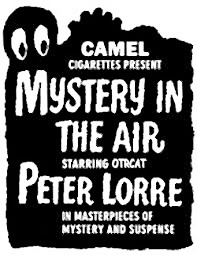
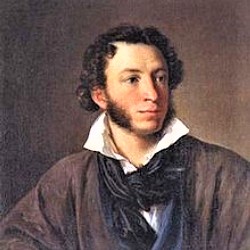 Mystery in the Air (July 3-Sept. 25, 1947) aired “The Queen of Spades” on September 11, 1947 as the 11th of its 13 episodes. The show was a summer replacement for The Abbott and Costello Show (1940-49). It featured stories of mystery, horror, and suspense and starred famed horror film actor Peter Lorre (1904-1964), who had always desired to star in a show of his own. Mystery in the Air was just the show for him and he made the best of it, playing his characters to the hilt while turning in some of his most memorable radio performances.
Mystery in the Air (July 3-Sept. 25, 1947) aired “The Queen of Spades” on September 11, 1947 as the 11th of its 13 episodes. The show was a summer replacement for The Abbott and Costello Show (1940-49). It featured stories of mystery, horror, and suspense and starred famed horror film actor Peter Lorre (1904-1964), who had always desired to star in a show of his own. Mystery in the Air was just the show for him and he made the best of it, playing his characters to the hilt while turning in some of his most memorable radio performances.
“The Queen of Spades” was written by Alexander Pushkin (1799-1837, photo top right) and first appeared as a short story in a Russian magazine in 1834. Pushkin is considered by many to be Russia’s greatest poet and the founder of Russian Literature. The great Russian composer Tchaikovsky turned the story into an opera in 1890, and it was adapted into several silent films in the early 20th century. Pushkin’s early death is the result of jealousy, when he believed his wife was having an affair and the affair had become some measure of public gossip. To save face he issued a challenge to duel his wife’s alleged lover, and in early February of 1837 Pushkin was shot in the abdomen, dying two days later of peritonitis.
Of interest is that Harry Morgan (1915-2011) was the narrator of the show, Morgan being the much respected and beloved actor best known for his TV roles as officer Bill Gannon, the third and final partner of Sergeant Joe Friday (Jack Webb) on Dragnet, and Colonel Sherman Potter on M.A.S.H.
“The Queen of Spades” is the story of Hermann, a German officer in the Imperial Russian Army, who watches as his fellow officers gamble, though he never himself plays. He becomes obsessed when one of the soldiers tells the story (which he believed to be true) of a certain Countess who held the secret of how to win at faro and win large sums of money. Tracking down the elderly Countess he holds her at gunpoint for the secret she refuses to reveal, but when she dies of fright at the sign of the gun he runs. Circumstances then lead him to attend the old lady’s funeral, whereupon what appears to be a supernatural occurrence takes place and the secret to the three winning faro numbers is revealed to him. I shan’t reveal more save that it involves the dead Countess and a scary reveal dealing with the three winning faro numbers. Critics have argued over the meaning of the tale and whether or not it was a story of severe obsession made real or a true tale of supernatural intrusion into our world. Either way, it is a classic story of horror, the only point of controversy coming from the nature of the horror. Listen now to this nicely adapted episode and decide for yourself, as the one and only Peter Lorre turns in another of his classic radio performances and learns the secret of “The Queen of Spades.”
(Left: Peter Lorre – Center: Peter Lorre at mic, Harry Morgan standing 2nd from right. – Right: Harry Morgan)
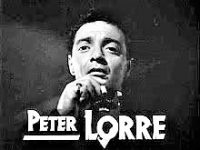
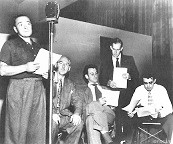
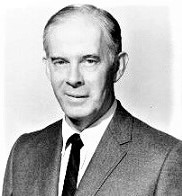
Play Time: 29:39
{“The Queen of Hearts” aired on September 11th, 1947, on a Thursday evening. The following day after school and the beginning of another weekend of freedom, the neighborhood gang could be found at their favorite haunt and home away from home, the corner newsstand, eager to add to their ever-growing collection of fantastic literature. Astounding SF (1930-present, now Analog) was a foregone automatic purchase, even if no cover stories or authors were used as an inducement on the cover below. Inducement enough would be a quick glance at the table of contents which featured, among others, stories by such luminaries as George O. Smith, Eric Frank Russell, Part 2 of 3 of a serial by L. Ron Hubbard, and Jack Vance. The stunning cover was by popular artist Alejandro. Astounding held to its usual monthly schedule in 1947. Avon Fantasy Reader (1947-52) was edited by future DAW Books publisher Donald A. Wollheim. It ran for a total of 16 issues: 5 were produced in 1947 (No. 4 is shown below), 3 each in the years 1948-51, and a final issue in 1952. It featured reprints from some of the biggest and most revered names in fantssy, horror, and the supernatural, including but not limited to, Robert E. Howard, H. P. Lovecraft, Ray Bradbury, A. Merritt, Clark Ashton Smith, Robert Bloch, Lord Dunsany, and August Derleth. Noted for its seductive, virtually nude females on its covers (all but maybe 3 featured an almost nude female, saved from the censors by varied nipple coverings), it ran much top flight classic material. Thrilling Wonder Stories (1936-55) was another favorite of the neighborhood gang, popular for its colorful adventure stories where science and logic often took a backseat to the unfettered imaginings of its popular authors. Not considered one of the “top-tier” SF pulps, it yet managed to acquire stories by the likes of, as indicated on the cover below, James MacCreigh (one of Fred Pohl’s pseudonyms), Robert Heinlein, Margaret St. Clair, Manly Wade Wellman, the versatile Henry Kuttner, and of all people Leslie Charteris, creator of the pre-James Bond-like Simon Templar (professional thief and amateur detective among other designations), who solved various crimes and huntred criminals in the fashion of the soft-boiled detective, and who became known as the Saint. TWS was a bi-monthly in 1947.}
[Left: Astounding, 9/47 – Center: Avon Fantasy Reader, 9/47 – Right: Thrilling Wonder Stories, 10/47]
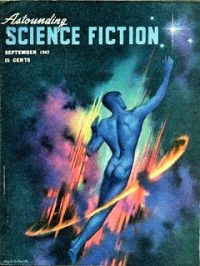
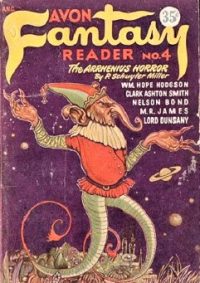
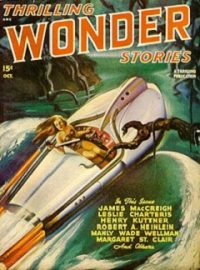
To view the entire list of weekly Old Time Radio episodes at Tangent Online, click here.